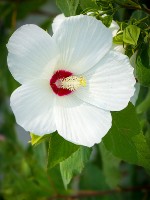Mon-Fri 9am - 5pm Mountain time
Swamp Rose Mallow (Hibiscus) vs Anise Hyssop
Hibiscus moscheutos
Agastache foeniculum
NOT AVAILABLE THIS SEASON - MIGHT RETURN
NOT AVAILABLE THIS SEASON - MIGHT RETURN
Swamp Rose Mallow (Hibiscus) has large white-pink showy flowers which attract hummingbirds and pollinators to your yard. It is a tall, fast growing perennial shrub. The flowers typically only last 1-2 days, but the plant will continue to rebloom throughout the season.
This hibiscus tolerates heat and humidity but does not do well when exposed to wind. Make sure the plant has access to lots of moisture for better flowering.
The Swamp Rose Mallow (Hibiscus) is also known as the dinner plate hibiscus because it can grow incredibly large flowers, as big as dinner plates.
Anise Hyssop is a native perennial wildflower known for its fragrant spikes of small purple flowers. This plant is an excellent source of nectar and is highly attractive to a variety of bees and other pollinators. Deadheading spent flowers will encourage more blooms throughout the season.
Its aromatic leaves release an anise-like (licorice) scent when crushed. Both the leaves and seeds are edible and have been used in teas and as flavouring. Leaves can be harvested at any time, though the oil content is highest just past full bloom. Deer tend to avoid Anise Hyssop because of its strong-smelling leaves. This makes it a useful plant for positioning as a protective border around more vulnerable species.
Anise Hyssop spreads by seeds and rhizomes, but is less aggressive than other members of the mint family and is easy to remove if needed. Historically, it was planted in large numbers as a honey plant to support apiaries. Birds also feed on its seeds, adding to its ecological value.

